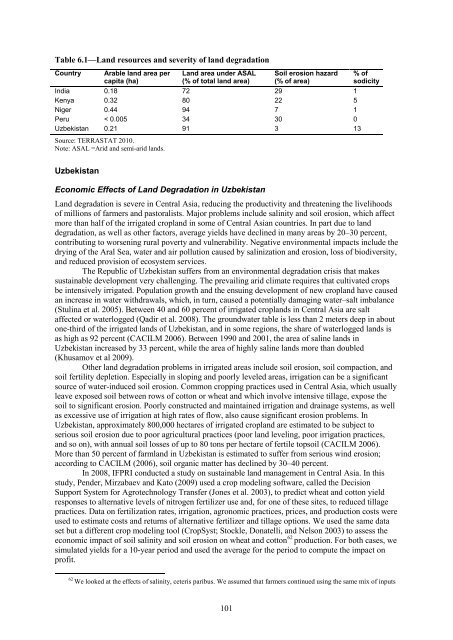The Economics of Desertification, Land Degradation, and Drought
The Economics of Desertification, Land Degradation, and Drought
The Economics of Desertification, Land Degradation, and Drought
Create successful ePaper yourself
Turn your PDF publications into a flip-book with our unique Google optimized e-Paper software.
Table 6.1—<strong>L<strong>and</strong></strong> resources <strong>and</strong> severity <strong>of</strong> l<strong>and</strong> degradation<br />
Country Arable l<strong>and</strong> area per<br />
capita (ha)<br />
<strong>L<strong>and</strong></strong> area under ASAL<br />
(% <strong>of</strong> total l<strong>and</strong> area)<br />
101<br />
Soil erosion hazard<br />
(% <strong>of</strong> area)<br />
India 0.18 72 29 1<br />
Kenya 0.32 80 22 5<br />
Niger 0.44 94 7 1<br />
Peru < 0.005 34 30 0<br />
Uzbekistan 0.21 91 3 13<br />
Source: TERRASTAT 2010.<br />
Note: ASAL =Arid <strong>and</strong> semi-arid l<strong>and</strong>s.<br />
Uzbekistan<br />
Economic Effects <strong>of</strong> <strong>L<strong>and</strong></strong> <strong>Degradation</strong> in Uzbekistan<br />
% <strong>of</strong><br />
sodicity<br />
<strong>L<strong>and</strong></strong> degradation is severe in Central Asia, reducing the productivity <strong>and</strong> threatening the livelihoods<br />
<strong>of</strong> millions <strong>of</strong> farmers <strong>and</strong> pastoralists. Major problems include salinity <strong>and</strong> soil erosion, which affect<br />
more than half <strong>of</strong> the irrigated cropl<strong>and</strong> in some <strong>of</strong> Central Asian countries. In part due to l<strong>and</strong><br />
degradation, as well as other factors, average yields have declined in many areas by 20–30 percent,<br />
contributing to worsening rural poverty <strong>and</strong> vulnerability. Negative environmental impacts include the<br />
drying <strong>of</strong> the Aral Sea, water <strong>and</strong> air pollution caused by salinization <strong>and</strong> erosion, loss <strong>of</strong> biodiversity,<br />
<strong>and</strong> reduced provision <strong>of</strong> ecosystem services.<br />
<strong>The</strong> Republic <strong>of</strong> Uzbekistan suffers from an environmental degradation crisis that makes<br />
sustainable development very challenging. <strong>The</strong> prevailing arid climate requires that cultivated crops<br />
be intensively irrigated. Population growth <strong>and</strong> the ensuing development <strong>of</strong> new cropl<strong>and</strong> have caused<br />
an increase in water withdrawals, which, in turn, caused a potentially damaging water–salt imbalance<br />
(Stulina et al. 2005). Between 40 <strong>and</strong> 60 percent <strong>of</strong> irrigated cropl<strong>and</strong>s in Central Asia are salt<br />
affected or waterlogged (Qadir et al. 2008). <strong>The</strong> groundwater table is less than 2 meters deep in about<br />
one-third <strong>of</strong> the irrigated l<strong>and</strong>s <strong>of</strong> Uzbekistan, <strong>and</strong> in some regions, the share <strong>of</strong> waterlogged l<strong>and</strong>s is<br />
as high as 92 percent (CACILM 2006). Between 1990 <strong>and</strong> 2001, the area <strong>of</strong> saline l<strong>and</strong>s in<br />
Uzbekistan increased by 33 percent, while the area <strong>of</strong> highly saline l<strong>and</strong>s more than doubled<br />
(Khusamov et al 2009).<br />
Other l<strong>and</strong> degradation problems in irrigated areas include soil erosion, soil compaction, <strong>and</strong><br />
soil fertility depletion. Especially in sloping <strong>and</strong> poorly leveled areas, irrigation can be a significant<br />
source <strong>of</strong> water-induced soil erosion. Common cropping practices used in Central Asia, which usually<br />
leave exposed soil between rows <strong>of</strong> cotton or wheat <strong>and</strong> which involve intensive tillage, expose the<br />
soil to significant erosion. Poorly constructed <strong>and</strong> maintained irrigation <strong>and</strong> drainage systems, as well<br />
as excessive use <strong>of</strong> irrigation at high rates <strong>of</strong> flow, also cause significant erosion problems. In<br />
Uzbekistan, approximately 800,000 hectares <strong>of</strong> irrigated cropl<strong>and</strong> are estimated to be subject to<br />
serious soil erosion due to poor agricultural practices (poor l<strong>and</strong> leveling, poor irrigation practices,<br />
<strong>and</strong> so on), with annual soil losses <strong>of</strong> up to 80 tons per hectare <strong>of</strong> fertile topsoil (CACILM 2006).<br />
More than 50 percent <strong>of</strong> farml<strong>and</strong> in Uzbekistan is estimated to suffer from serious wind erosion;<br />
according to CACILM (2006), soil organic matter has declined by 30–40 percent.<br />
In 2008, IFPRI conducted a study on sustainable l<strong>and</strong> management in Central Asia. In this<br />
study, Pender, Mirzabaev <strong>and</strong> Kato (2009) used a crop modeling s<strong>of</strong>tware, called the Decision<br />
Support System for Agrotechnology Transfer (Jones et al. 2003), to predict wheat <strong>and</strong> cotton yield<br />
responses to alternative levels <strong>of</strong> nitrogen fertilizer use <strong>and</strong>, for one <strong>of</strong> these sites, to reduced tillage<br />
practices. Data on fertilization rates, irrigation, agronomic practices, prices, <strong>and</strong> production costs were<br />
used to estimate costs <strong>and</strong> returns <strong>of</strong> alternative fertilizer <strong>and</strong> tillage options. We used the same data<br />
set but a different crop modeling tool (CropSyst; Stockle, Donatelli, <strong>and</strong> Nelson 2003) to assess the<br />
economic impact <strong>of</strong> soil salinity <strong>and</strong> soil erosion on wheat <strong>and</strong> cotton 62 production. For both cases, we<br />
simulated yields for a 10-year period <strong>and</strong> used the average for the period to compute the impact on<br />
pr<strong>of</strong>it.<br />
62 We looked at the effects <strong>of</strong> salinity, ceteris paribus. We assumed that farmers continued using the same mix <strong>of</strong> inputs

















